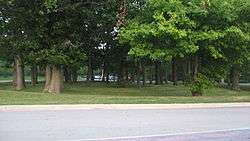Enclosure (archaeology)
In archaeology, an enclosure is one of the most common types of archaeological site. It is any area of land separated from surrounding land by earthworks, walls or fencing.[1] Such a simple feature is found all over the world and during almost all archaeological periods. They may be few metres across or be large enough to encompass whole cities.

Enclosures served numerous practical purposes including acting to delineate settlement areas, to create defensive positions or to be used as animal pens. They were also widely adopted in ritual and burial practices however and seem to demonstrate a fundamental human desire to make physical boundaries around spaces. Enclosures created from ditches and banks or walling can often be identified in the field through aerial photography or ground survey. Other types leave less permanent records and may only be identified during excavation.
Types of enclosure
References
- Project, Damerham Archaeology. "Damerham Archaeology Project | The Damerham Site". www.damerhamarchaeology.org. Retrieved 2016-09-18.